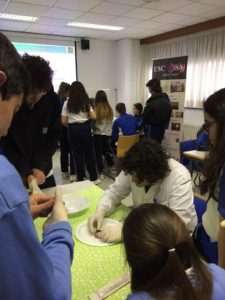Unfortunately during this year the Young Minds Section did not have any outreach activity with students in our Headquarters. Therefore we are not able to use the Human-Size camera obscura. However, we build different portable size camera obscura and we brougth it to our outreach activities in the schools. Next year we plan to be part of the science week organized by the University, in this case we are sure we can use the human-size camera obscura.
Regardless the problem to do this activity, the group made an effort to bring students a fresh vision about optics in different school activities, bringing brand new activities like dissecting cow eyes in order to show how an eye works and its parts. Moreover the group is concerned about the important of the gender equality, for this reason we continue collaborating with the city council in an activity called: “A woman scientist in each school” that is its third edition and has a big impact and good acceptance among teachers and students.
Moreover the group is concerned with the professional development of its members and the surrounding scientific community of the University of Santiago de Compostela, for this reason the group has organized several conferences and lectures this year about different topics in optics. In January we brought professor Pieter de Beule from the International Iberian Nanotechnology Laboratory from Braga, Portugal, with the talk: Overview Research Activities Applied Nano-Optics Team. In March, Raul Rangel from CICESE (Mexico) made a conference called: Nano Structured materials for nonlinear optics and wave guiding devices. Finally, in July we brought Prof. Virendra Mahajan from the College of Optical Science with the talk entitled: Axial Irradiance of a focused beam.
Spreading Optics through the University
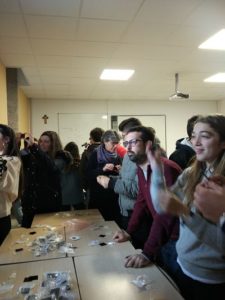 One more year, the USC EPS Young Minds Section devotes its efforts in outreach activities, focused in particular on the youngest. During this period, we have organised visits oriented to students of different local schools. The section members have gone to their classes and also the children have come to the Optics Faculty from University of Santiago de Compostela. In both situations, concepts explained to them were the same but the visit to the Faculty seems to be more enlightening due to the fact that they are able to visit the installations of the University as well as real Optics laboratory. Different research lines, where the YM Section members are involved, are shown to them and also the equipment of the laboratory and their basic functioning, such as pulsed lasers. The activities were distributed in four main blocks, as it was proposed in the Activity “Spreading Optics through the University” in the previous report. Nevertheless, the activity of holograms has been replaced for another one due to the material that was available in that moment. The performed activities were (1) polarization, (2) lens, (3) fluorescence and (4) refraction and reflexion. In (1), two little polarizers were given to the students to explain the concept, as well as a piece of a plastic fork to perform a tension essay using polarization. In (2), using a special kit of lenses and a schematic image of the human eye, myopia and hyperopia, as well as how they are corrected, were explained. In (3), we employed laser pointers, fluorescent markers, olive oil and gummies for explaining fluorescence and the light matter interaction. Finally, in (4) laser pointers, a methacrylate block and optic fibres were used. The main part of the budget has been employed in the bought of new material for the activities.
One more year, the USC EPS Young Minds Section devotes its efforts in outreach activities, focused in particular on the youngest. During this period, we have organised visits oriented to students of different local schools. The section members have gone to their classes and also the children have come to the Optics Faculty from University of Santiago de Compostela. In both situations, concepts explained to them were the same but the visit to the Faculty seems to be more enlightening due to the fact that they are able to visit the installations of the University as well as real Optics laboratory. Different research lines, where the YM Section members are involved, are shown to them and also the equipment of the laboratory and their basic functioning, such as pulsed lasers. The activities were distributed in four main blocks, as it was proposed in the Activity “Spreading Optics through the University” in the previous report. Nevertheless, the activity of holograms has been replaced for another one due to the material that was available in that moment. The performed activities were (1) polarization, (2) lens, (3) fluorescence and (4) refraction and reflexion. In (1), two little polarizers were given to the students to explain the concept, as well as a piece of a plastic fork to perform a tension essay using polarization. In (2), using a special kit of lenses and a schematic image of the human eye, myopia and hyperopia, as well as how they are corrected, were explained. In (3), we employed laser pointers, fluorescent markers, olive oil and gummies for explaining fluorescence and the light matter interaction. Finally, in (4) laser pointers, a methacrylate block and optic fibres were used. The main part of the budget has been employed in the bought of new material for the activities.
The activity has taken a very good reception from the students, due to its versatility and the self-made experimentation that they are able to do in each block. Also teachers consider an interesting activity because it is focused in science while it is very common to find activities focusing on Arts or humanistic fields in the surroundings. A prove of the success of the activity is the fact that last year schools ask for information to repeat the activity. In conclusion, we consider that this activity has enough impact to be done several times per year.
Light Talks
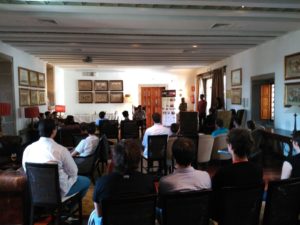 As we have written down in our Grant request form, we want to perform a scientific coffee with some of the former members of the student chapter. However, the performance of the OPTOEL congress in our city gives us the possibility to take advantage of this and perform a more impact activity. Therefore we have organized a scientific coffee during the congress. This event was performed in the afternoon of the 13th of July in the same place as the OPTOEL and it was devoted to the students that attended to the congress. In this scientific coffee, two international recognized researchers form different areas share their experiences in the science career with the attendees. We counted with Dr. Xingde Li, whose research is focused in biomedical image, and with Dr. Olivier Chalus, expert in high power lasers and Project Manager R&D Scientist at Thales Optronique SA. In this event, the participants had the opportunity to ask the researchers about their experiences and opinions and to interact with them in a closest way that in other congress event will not be possible. As Section, we believe that this activity was very satisfactory for both the attendees and the members of the section, since as group we have improve our organization skills by participating in the organization of this event in parallel with the Optoelectronics Congress. We strongly believe that take advantage of the OPTOEL congress was the best decision to make a scientific coffee with high impact that usually a small city like ours is not able to perform. However we are planning to perform in next months the scientific coffee with former members. We believe that this is also an important event for grade students who are still thinking about their future after the University studies.
As we have written down in our Grant request form, we want to perform a scientific coffee with some of the former members of the student chapter. However, the performance of the OPTOEL congress in our city gives us the possibility to take advantage of this and perform a more impact activity. Therefore we have organized a scientific coffee during the congress. This event was performed in the afternoon of the 13th of July in the same place as the OPTOEL and it was devoted to the students that attended to the congress. In this scientific coffee, two international recognized researchers form different areas share their experiences in the science career with the attendees. We counted with Dr. Xingde Li, whose research is focused in biomedical image, and with Dr. Olivier Chalus, expert in high power lasers and Project Manager R&D Scientist at Thales Optronique SA. In this event, the participants had the opportunity to ask the researchers about their experiences and opinions and to interact with them in a closest way that in other congress event will not be possible. As Section, we believe that this activity was very satisfactory for both the attendees and the members of the section, since as group we have improve our organization skills by participating in the organization of this event in parallel with the Optoelectronics Congress. We strongly believe that take advantage of the OPTOEL congress was the best decision to make a scientific coffee with high impact that usually a small city like ours is not able to perform. However we are planning to perform in next months the scientific coffee with former members. We believe that this is also an important event for grade students who are still thinking about their future after the University studies.
Spreading Optics in the School
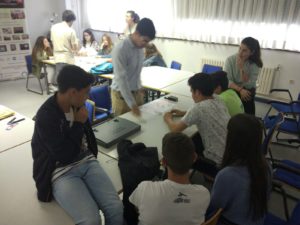 One more year, the USC Young Minds Section is devoted to outreach activities in several topics of Optics for children of different ages, from five to eighteen years old. In particular, in this academic course we have performed two activities with schools, one for children from primary level and another with kids from secondary. The experiences performed during these events were the same in both cases but adapted to their level of knowledge and age. Briefly, each member of the YM Section performs one Optics experience to a reduced group of 10-15 children in order to have a more personalized attention. These activities are: 1) the functioning of the eye, where ametropies such as myopia or hyperopia are explained as well as how the human eye works by using different lenses. 2) Light-mater interaction, where concepts like fluorescence are shown by using laser pointers and olive oil or white paper. 3) Polarization, where this phenomena is explained in asimple way and some of its applications, like cinema glasses, are shown. 4) Light propagation, where concepts like reflection, refraction and transmission are explained as well as some fiber optics applications in their daily life are shown. This activity has had a very good reception among teachers and children. Since we have performed this Optics experiences from some years, we count with the contact of some schools that are interested in our activities year on year, making more easy to organize this event and to combine it with the duties of the member of the Young Minds Section.
One more year, the USC Young Minds Section is devoted to outreach activities in several topics of Optics for children of different ages, from five to eighteen years old. In particular, in this academic course we have performed two activities with schools, one for children from primary level and another with kids from secondary. The experiences performed during these events were the same in both cases but adapted to their level of knowledge and age. Briefly, each member of the YM Section performs one Optics experience to a reduced group of 10-15 children in order to have a more personalized attention. These activities are: 1) the functioning of the eye, where ametropies such as myopia or hyperopia are explained as well as how the human eye works by using different lenses. 2) Light-mater interaction, where concepts like fluorescence are shown by using laser pointers and olive oil or white paper. 3) Polarization, where this phenomena is explained in asimple way and some of its applications, like cinema glasses, are shown. 4) Light propagation, where concepts like reflection, refraction and transmission are explained as well as some fiber optics applications in their daily life are shown. This activity has had a very good reception among teachers and children. Since we have performed this Optics experiences from some years, we count with the contact of some schools that are interested in our activities year on year, making more easy to organize this event and to combine it with the duties of the member of the Young Minds Section.
OPTOEL2017
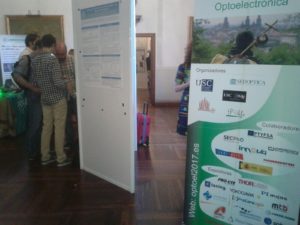 This year the OPTOEL congress (Spanish Congress of Optoelectronic) was held in Santiago de Compostela from the 12th to the 14th of July. It was organized by our University (Universidade de Santiago de Compostela) and, in particular, by the Photonics4Life research group where most of the members of the Young Minds Section are doing their PhD studies. The members of the Section were actively participating in the organization of the congress and with the help of the funding received with the grant “EPSYM2017A32-200€”. The money of the grant was used to print some advertisement of the chapter and with a contribution into the congress. Moreover we became officially part of the organizators of the congress with our economical contribution plus the work of the YM Section. We made a special effort in getting involved the youngest members of the group, so we introduce them in the leading role of managing a congress and giving support to the main organizers.
This year the OPTOEL congress (Spanish Congress of Optoelectronic) was held in Santiago de Compostela from the 12th to the 14th of July. It was organized by our University (Universidade de Santiago de Compostela) and, in particular, by the Photonics4Life research group where most of the members of the Young Minds Section are doing their PhD studies. The members of the Section were actively participating in the organization of the congress and with the help of the funding received with the grant “EPSYM2017A32-200€”. The money of the grant was used to print some advertisement of the chapter and with a contribution into the congress. Moreover we became officially part of the organizators of the congress with our economical contribution plus the work of the YM Section. We made a special effort in getting involved the youngest members of the group, so we introduce them in the leading role of managing a congress and giving support to the main organizers.
Specifically the YM Section was in charge of the reception and check-in of all the investigators plus giving any advice about the city. Finally we also participate in the congress giving some technical support like printing information panels or preparing the attendees’ gift.
As a section we believe that taking part of the organization of the OPTOEL 2017 allow us to improve key features in our following careers. We were able to improve our networking with some colleagues from other sections and to give more visibility to this kind of young students group.
Spreading Optics in the school
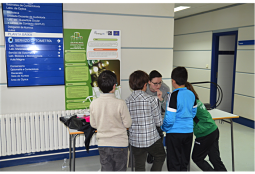 As it is usual in the USC-EPS Young Minds Section, we have performed several outreach activities in local Schools. Those activities are addressed to students from 5 up to 18 years old. In order to overcome the high range of ages we have, we offer to the schools a set of activities that will be tuned in order to fit with their necessities.
As it is usual in the USC-EPS Young Minds Section, we have performed several outreach activities in local Schools. Those activities are addressed to students from 5 up to 18 years old. In order to overcome the high range of ages we have, we offer to the schools a set of activities that will be tuned in order to fit with their necessities.
During the last year we have visited 4 local schools to develop our experiments mainly with children of primary school (below 12). However, we have performed some outreach activities in the faculty (2 activities with a total of 50 students). This new approach allow us to perform some experiments that can not be done in the schools, for example, a hologram activity where children learn about the nature of those items and how it can be built. The experiments in the faculty has some drawbacks, like the renting of some space to perform these experiments. In this case we have pushed the university to collaborate with the section in order to use some space for free.
As it was stated in the grant application, we asked for money in order to buy some optical elements that usually get broken during the activities (specially when small children are involved) like polarizers, diffraction gratings, etc. In this particular case we have bought thin film polarizers that are the easiest item to lose when we perform our experiments.
In conclusion, we considered that a natural step for our section is to push the schools to come to the faculty, where new experiments can be done avoiding their transportation. With this approach we can also offer visits to the faculty and their labs focused on pre-university students.
Light Interferences – Optics in School
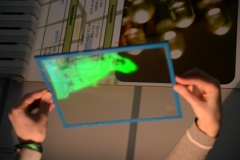 As it is usual in the USC Young Minds Section, spreading optics and photonics through the Spanish educational system is a must. Last grant submission we asked for money to make experiments in the faculty instead of going to the schools. Main advantage of the performance of our activity in the faculty is the ease to make the same experiments than in the schools plus additional ones that cannot be done outside a lab.
As it is usual in the USC Young Minds Section, spreading optics and photonics through the Spanish educational system is a must. Last grant submission we asked for money to make experiments in the faculty instead of going to the schools. Main advantage of the performance of our activity in the faculty is the ease to make the same experiments than in the schools plus additional ones that cannot be done outside a lab.
The grant requested was for making a duality particle wave experiment. The idea was to make or to build a Ripple tank to explain the behaviour of the waves through a double slit. Unfortunately the total budget requested for the performance of this activity was to high to be supported by the funding of the Student Section. A new point of view was needed to make an interference experiment, which was at the beginning our main idea.
The new proposal was to make holograms in collaboration with one of our University labs. This activity has been done two times during the first semester: first with high capability students (17 in total) and a second one with students from 5th grade (which corresponds with students between 10 and 11 years old, 60 students in total). In combination with the old activities that we usually perform (Fiber optics, Interaction matter-radiation, Polarization, Visual Optics) we perform a new one related with Holograms. Therefore students came to our faculty and made 5 experiments separately.
Previous to the performance of the activity we produce a number of holograms to show it to the students so the main part of the budget was used to buy photographic material to print the hologram. No more material was needed because a holographic experiment is done during the physics grade and therefore we made ours only paying for the spare items so the laser, and optical material was in the lab.
After the fabrication of the holograms we show students how to make it and their properties. By simply using a lamp we show the recovery of the holograms and their characteristics. With this new idea we can explain some features of the interferometric behaviour of optical pulses, which is in fact one of the main points of the optics that we have not implemented yet in our Spreading optics activity.
Meet the Light
Meet the Light is an activity where the main objective of different activities is to raise awareness of how light plays a central role in our lives, mainly among the general public. With these activities we want to present an accurate and engaging perspective on what light is really about and how it has influenced and improved our lives.
The Santiago de Compostela YM Section carried out the following activities within the frame of “Meet the Light” event:
- Course “Introduction to photography” by Ángel Sánchez García. Place: Aula Magna Carlos Gómez Reino in the Faculty of Optics and Optometry, University of Santiago de Compsotela, Galicia, Spain.
Date: 4/12/2014 - Lecture by professor Salvador Bará Viñas “WHAT YOU NEED TO KNOW TO BUY SOME GOOD BINOCULARS AND TELESCOPE”.
Place: Sala de Xuntas da Faculty de Física da USC, Santiago de Compostela.
Date: 11/12/2014 - Photography workshop, by Ángel Sánchez García. Place: Santiago de Compostela, Galicia, Spain.
Date: 8/05/2015 - Workshop in astronomy, “A look into the sky”, by professor Salvador Bará Viñas.
Place: Santiago de Compostela, Galicia, Spain. Date: 25/05/2015
Reunión Nacional de Óptica Joven, RNOJ (Young Optics Spanish Meeting)
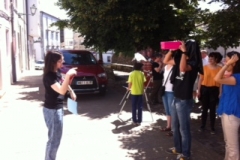 One of the most important national meetings is the RNO (Reunión Nacional de Óptical) that was held in Salamanca. Due to our work as PhD Students, this meeting is a great opportunity to meet other YM Section and to perform some activities and improve our social network.
One of the most important national meetings is the RNO (Reunión Nacional de Óptical) that was held in Salamanca. Due to our work as PhD Students, this meeting is a great opportunity to meet other YM Section and to perform some activities and improve our social network.
In this case the Student Chapter from Salamanca proposed an outdoor activity during the afternoon. In this case the proposal was to make some experiments in one of the major squares in Salamanca. In our case, the proposal was to bring some of our material from Santiago and make one of the experiments we usually make. In this case we propose the performance of some activites we make in a local festival in Santiago (“Festa da Primavera”). We brought material like our Tindall Experiment or our portable black camera.
Moreover the outreach performed by the different student groups, the RNOJ was a good possibility to exchange our feelings about optics, our YM activities and the improvement of our social connections.
This activity is important to make strong connections and to make new collaborations between the groups. As an example we talked with the YM Section from Valladolid and with the OSA Student Chapter from Salamanca about to make some activities in the St. James Way. In this case we need to make efforts if we want to make possible this kind of huge purposes, however we think that it is a significant example about how important are this kind of meetings between the young researchers and their Students groups.
Light Videos
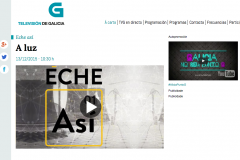 Light Videos was an idea to arouse awareness about optics using Internet. We proposed to make different videos about optics. We have prepared a number of theme blocks: Physical explanations, Optics experiments and physical curiosities.
Light Videos was an idea to arouse awareness about optics using Internet. We proposed to make different videos about optics. We have prepared a number of theme blocks: Physical explanations, Optics experiments and physical curiosities.
The idea of the Physical explanations is to show some features of physical phenomena that cannot be performed in outdoor activities. For this block we need the collaboration of the professors of the faculty in order to open their labs. The members of the YM Section are mainly from a group that works with lasers. For this reason we have prepared explaining, for example, how a lab Laser works.
Optics experiments were planned as a tool for all the educational community. First experiments were the ones we make in our basic optics in the school activity. With this proposal we want to make teachers able to do the experiments by their own. Moreover we plan to make some video hints in the future for Grade students of physics that want to know more about the experiments they perform in the lab lessons.
Regarding the film outreach of physics, we start to collaborate with a local group of TV producers that have made during the year a programmer for the region TV called: “Eche así”. This programme has been emitted weekly during the summer. One of the programs was dedicated to optics. In this case we collaborate with some material purchased with EPS and OSA grants and also with our personal collaboration.
This collaboration will last during 2016 with new collaboration we planned with these group and we hope to make some video interviews talking about optics for them.

